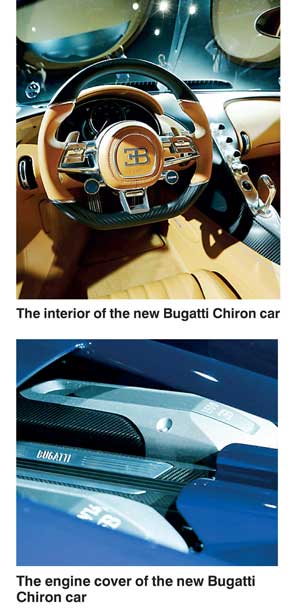Wednesday Oct 22, 2025
Wednesday Oct 22, 2025
Thursday, 3 March 2016 00:00 - - {{hitsCtrl.values.hits}}

Bugatti CEO Wolfgang Duerheimerposes during the presentation of the new Bugatti Chiron ahead of the 86th International Motor Show in Geneva, Switzerland, 29 February – Reuters
Reuters: Bugatti unveiled the world’s fastest road car at the Geneva auto show this week: the 2.4 million euro ($2.6 million) Chiron with a 1,500 horsepower engine that can hit 420 kilometres per hour.
Also on display is the Lamborghini Centenario, almost modest by comparison with a 770 horsepower engine, a price tag of 1.75 million euros and a top speed of around 350 kilometres per hour.
 One thing the supercars have in common is that they are both made by Volkswagen, the German carmaker facing billions of dollars of fines and years of damage limitation after cheating diesel emissions tests in the United States.
One thing the supercars have in common is that they are both made by Volkswagen, the German carmaker facing billions of dollars of fines and years of damage limitation after cheating diesel emissions tests in the United States.
For some analysts, the extravagance is misplaced at a time Europe’s largest carmaker has been forced to postpone its 2015 results while it tries to put a price on the emissions scandal, and its core VW brand steps up cost saving plans.
Volkswagen (VW) has pledged to pull funding from all non-essential projects and Chief Executive Matthias Mueller said in October it would examine the profit contribution of each of its over 310 models as part of the company’s belt tightening.
“VW must decide what their future focus should be. That entails the question whether the super-luxury business is needed?” said Stefan Bratzel, head of the Center of Automotive Management think-tank near Cologne. “This cannot be the future direction of VW.”
While the company does not publish a detailed breakdown of how much it costs to develop and produce its supercars, nor whether they contribute to the bottom line, past research has argued that they are loss-leaders.
Bernstein Research in 2013 said the Chiron’s predecessor – the Veryon – was one of the six “most loss-making European cars of modern times”, estimating the loss per car at nearly five times its original sale price of one million euros.
Hanover-based NordLB analyst Frank Schwope said the French brand Bugatti, which has never been profitable since VW bought it in 1998, “is a superfluous asset and its role must be questioned even more in tough times”.
Some analysts say selling Bugatti or Italian supercar brand Lamborghini makes more sense for VW, to help it pay fines and legal costs linked to its emissions test-rigging scandal.
“Unwise to stop”
But to a certain extent, the decision has already been made. When the diesel scandal broke, CEO Mueller vowed not to sell any of VW’s brands and the Chiron, which had been in development for years, remained on course for its launch in Switzerland.
A source at VW said there was some criticism within top management as to whether the Bugatti supercar should be pushed to such extremes in light of the post-dieselgate environment, but Mueller himself agreed the work should continue.
The argument internally is that the engineering work carried out by Bugatti is a testing ground for technologies used in relatively more accessible brands such as Porsche and Bentley, which do contribute to the bottom line.
Porsche is the second biggest contributor to VW’s operating profit after Audi, VW sources say technical insights on the durability and stability of materials and components gathered by Bugatti are used directly by Porsche and Bentley.
“Of course, the critics at VW asked whether we need such a car,” Bugatti’s Chief Executive Wolfgang Duerheimer told Reuters. “But it would have been unwise to stop this project.”
Besides the technological spin-offs, continued spending by the super-rich in the United States, China and Europe may encourage VW to press ahead with the supercar extravaganza.
Deliveries of cars priced at 250,000 euros or more may increase 12% to 8,014 vehicles by 2020 from 7,182 this year, according to research firm IHS Automotive.
At Geneva, VW’s Bentley flaunted an all-new extended wheelbase version of its flagship Mulsanne saloon, especially catering to Chinese buyers with 250 millimetres (9.8 inches) of extra rear leg room and airline-style extending legrests.
Lamborghini said it would only make 40 Centenarios, which is the most powerful car in its 53-year history, and they were all sold before the doors to the Geneva car show opened.
A third of the planned 500 models of the Chiron had also been snapped up before the supercar’s unveiling.
“It’s part of human nature to break boundaries and to reach new records,” said Bugatti’s Duerheimer, who is also head of motorsports at VW. “People are driven by their aspirations, and so is Bugatti.”
 Lamborghini President and CEO Stephan Winkelmann presents the new Lamborghini Centenario at the 86th International Motor Show in Geneva, Switzerland, 1 March. REUTERS/Denis Balibouse
Lamborghini President and CEO Stephan Winkelmann presents the new Lamborghini Centenario at the 86th International Motor Show in Geneva, Switzerland, 1 March. REUTERS/Denis Balibouse